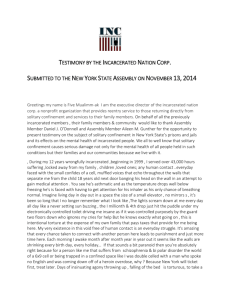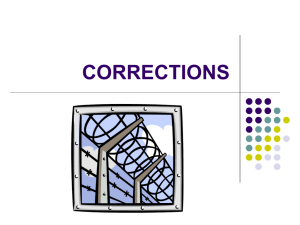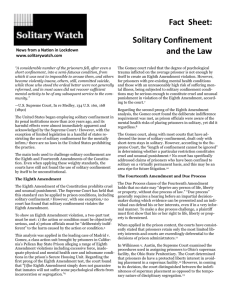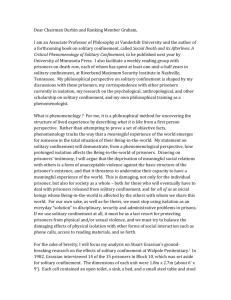Solitary Confinement - Newspaper In Education
advertisement
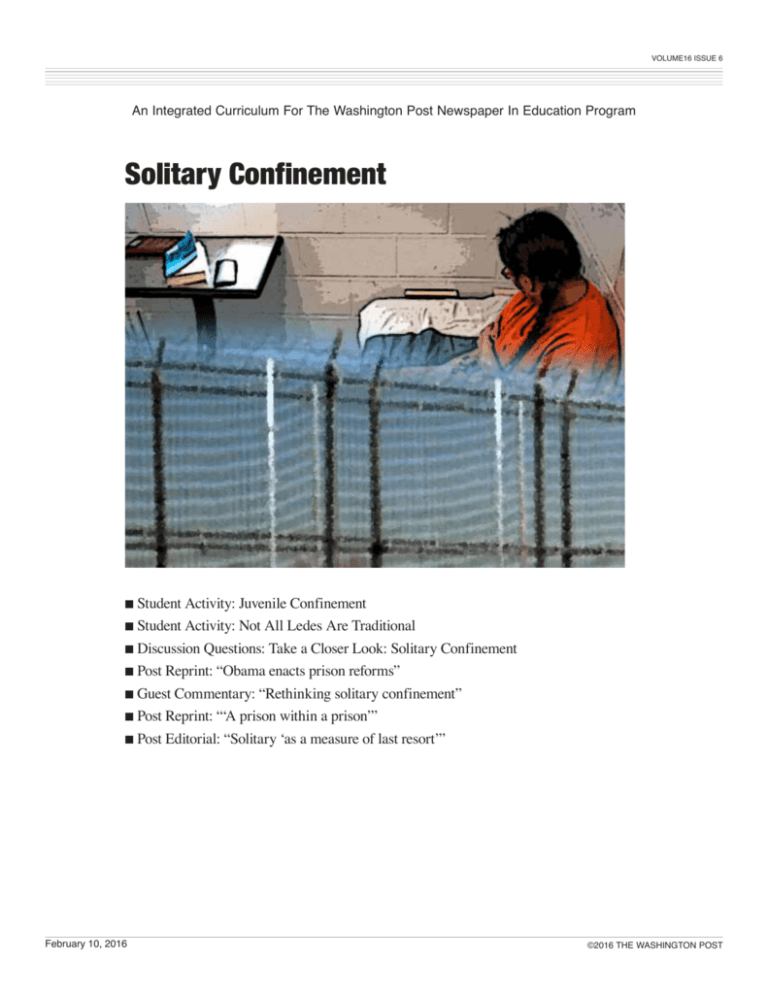
Volume16 Issue 6 An Integrated Curriculum For The Washington Post Newspaper In Education Program Solitary Confinement Student Activity: Juvenile Confinement ■ Student Activity: Not All Ledes Are Traditional ■ Discussion Questions: Take a Closer Look: Solitary Confinement ■ Post Reprint: “Obama enacts prison reforms” ■ Guest Commentary: “Rethinking solitary confinement” ■ Post Reprint: “‘A prison within a prison’” ■ Post Editorial: “Solitary ‘as a measure of last resort’” ■ February 10, 2016 ©2016 THE WASHINGTON POST Volume16 Issue 6 An Integrated Curriculum For The Washington Post Newspaper In Education Program P resident Obama in January 2016 announced he was taking executive action against solitary confinement of juveniles in federal prisons. In response to a Department of Justice review of the use of solitary confinement throughout the U.S., Mr. Obama argues “solitary confinement has the potential to lead to lasting psychological consequences,” gives examples of two states having positive results, and ties this measure to the bipartisan prison reform bill making its way through Congress. This action comes at the same time as the Supreme Court decision in Montgomery v. Louisiana and congressional consideration of the omnibus “Sentencing Reform and Corrections Act.” Teachers are provided with Washington Post news articles, editorials, blogs and reports as well as President Obama’s guest commentary to study solitary confinement of juveniles and to discuss the most recent movements to reform juvenile justice. February 10, 2016 2 ©2016 THE WASHINGTON POST Name ___________________________________________________________ Date _____________________________ Juvenile Confinement Whether writing a report or an article for your student newspaper or talking about youth offenders and youth confinement, it is important to get data from reliable sources. The U.S. Census Bureau, the U.S. Department of Justice Office of Juvenile Justice and Delinquency Prevention, and the Federal Bureau of Investigation provide data that is often analyzed and published by academics and researchers. 1. Read the chart that provides data about known juvenile offenders. Known juvenile homicide offenders by age, 1980-2013 SOURCE: U.S. Department of Justice Office of Juvenile Justice and Delinquency Prevention A. During what period did most homicides by juvenile offenders take place? B. What age groups committed the most homicides? C. What does the data communicate about similarities of all age groups? D. When have the fewest homicides been committed in the 34-year period? 2. Use the information that follows to create a bar graph. Be sure to give the graphic a title and to include the source of information. The rate: Youth confinement in the United States dropped by 41 percent between 1995 and 2010, from 381 per 100,000 youth to 225 per 100,000. Data: 1975, 241 youth per 100,000; 1983, 290 youth; 1991, 359 youth; 1995, 381 youth; 1997, 356 youth; 1999 and 2001, 355 youth; 2006, 295 youth; 2007, 278 youth; 2010, 225 youth per 100,000. Source: Office of Juvenile Justice and Delinquency Prevention Volume16 Issue 6 An Integrated Curriculum For The Washington Post Newspaper In Education Program 3. On October 24, 2012, 51% of juvenile facilities were publicly operated; they held 69% of juvenile offenders. Private facilities are operated by nonprofit or for-profit corporations. Public facilities are operated by state or local government agencies. Read the chart and answer the questions. A. How many juvenile offenders are held in juvenile facilities in the U.S.? B. Are most juvenile offenders housed in public or private facilities? C. Which three states have the fewest juvenile offenders? D. Which three states are housing the largest number of juvenile offenders? E. Which state has the highest number of private juvenile facilities? F. Review data for D.C., Virginia and Maryland. What comparisons can be made between the three jurisdictions? February 10, 2016 4 ©2016 THE WASHINGTON POST Volume16 Issue 6 An Integrated Curriculum For The Washington Post Newspaper In Education Program 4. The Office of Juvenile Justice and Delinquency Prevention provides data on the racial composition of youth confined in 1997 and in 2010. Use the information that follows to create a bar graph to communicate data by year and by race. The number indicates the rate per 100,000. Be sure to give the graphic a title and to include the source of information. Data: Asian and Pacific Islander: 195 per 100,000 in 1997, 47 in 2010; African American: 968 in 1997, 605 in 2010; American Indian: 490 in 1997, 367 in 2010; Hispanic: 468 in 1997, 229 in 2010; Non-Hispanic White: 201 in 1997, 127 in 2010. 5. In a July 14, 2015, speech at the NAACP National Convention, President Barack Obama announced that he had asked Attorney General Loretta Lynch to conduct a review of “the overuse of solitary confinement across American prisons.” The President directed that the purpose of the review not be simply to understand how, when, and why correctional facilities isolate certain prisoners from the general inmate population, but also to develop strategies for reducing the use of this practice throughout our nation’s criminal justice system. Read the press release from the White House regarding the Department of Justice Review of Solitary Confine- ment: http://www.whitehousepressbriefings.com/fact-sheets/fact-sheet-department-of-justice-review-of-solitary- confinement-january-25-2016. Select one of the DOJ recommendations. In two to three paragraphs, indicate why you believe this will, will not or only under certain conditions will be beneficial to juvenile offenders. You may combine the selected recommendation with one to two other recommendations if they influence your evaluation. February 10, 2016 ©2016 THE WASHINGTON POST Name ___________________________________________________________ Date _____________________________ Not All Ledes Are Traditional There is a time when the traditional news lede is best. As news breaks the Who, What, Where, When, Who and How give the facts and succinctly provide information. A variety lede — description, comparison, anecdote, for example — delay getting to the main news, but personalize and illustrate the point while drawing the reader into the article. Compare and contrast the two ledes about the same story. LEDE 1 By Juliet Eilperin Originally Published January 26, 2016 LEDE 2 By Terrence McCoy Originally Published January 30, 2016 President Obama on Monday announced a ban on solitary confinement for juvenile offenders in the federal prison system, saying the practice is overused and has the potential for devastating psychological consequences. He cannot forget the first day. White walls. Room the size of a ping-pong table. The silence. 1. What is the topic of both articles? 2. Juliet Eilperin uses a traditional news lede. Identify the 5Ws and H. Does the verb imply the How? 3. We are taught in composition lessons to have clear pronoun references. Why do you think Terrence McCoy breaks the rule beginning his article with “he”? How effective is this approach? 4. Both reporters use adjectives. Underline the adjectives in both ledes. What do they add to the reader’s understaning of the topic? 5. What is the angle taken by both writers? In what way do the two articles work together to give a fuller story of the issue? Name ___________________________________________________________ Date _____________________________ Take a Closer Look: Solitary Confinement You are asked to read a news article, an editorial and a guest commentary on the topic of solitary confinement. All were published in The Washington Post on January 26, 2016. After reading the pieces, answer the following questions. News: “Obama enacts prison reforms” Editorial: “Solitary ‘as a measure of last resort’” Commentary: “Rethinking solitary confinement” 1. What is the news that is the focus of each piece? 2. The editorial board writes as the voice of the newspaper. In which paragraph does The Post state its position? What is its stand on the use of solitary confinement? 3. President Obama begins with an anecdotal lede, relating the story of Kalief Browder. Post reporter Juliet Eilperin ends her news article with reference to Browder. a. Why does a writer use an anecdotal lede? b. News reporters face the potential “cut-off” of the last paragraph(s) in order to fit within the confined space of print editions. Eilperin took a chance. Why does she conclude with reference to Browder? c. Review the lede to the news article and its last three paragraphs. Discuss the effectiveness of her organization of information. 4. All three pieces make use of numbers. a. Categorize the figures that are given. For example, size of prison population. b. Select one category to compare the numbers presented in two of the selections. c. Which numbers do you find most interesting? Explain your answer. 5. Eilperin quotes several sources. a. Which source provides the most data-based information? b. Which source provides anecdotal information? c. Which source provides you with the most convincing information? Explain. 6. Reforming solitary confinement — which is one part of the move to reform of the criminal justice system — has an economic component. Provide some of the figures given and summarize the reasons given for reform being good economic sense. 7. Solitary confinement is one area addressed in the 50 “guiding principles” provided by the Justice Department. a. What is the intent of the principles? b. Name three other areas covered in the 50 principles. c. What is the potential impact of the 50 guiding principles? Volume16 Issue 6 An Integrated Curriculum For The Washington Post Newspaper In Education Program Obama enacts prison reforms NO SOLITARY CONFINEMENT FOR JUVENILES Executive actions also expand mental-health care By Juliet Eilperin •Originally Published January 26, 2016 President Obama on Monday announced a ban on solitary confinement for juvenile offenders in the federal prison system, saying the practice is overused and has the potential for devastating psychological consequences. In an op-ed that appears in Tuesday editions of The Washington Post, the president outlines a series of executive actions that also prohibit federal corrections officials from punishing prisoners who commit “low-level infractions” with solitary confinement. The new rules also dictate that the longest a prisoner can be punished with solitary confinement for a first offense is 60 days, rather than the current maximum of 365 days. The president’s reforms apply broadly to the roughly 10,000 federal inmates serving time in solitary confinement, though there are only a handful of juvenile offenders placed in restrictive housing each year. Between September 2014 and September 2015, federal authorities February 10, 2016 were notified of just 13 juveniles who were put in solitary in its prisons, officials said. However, federal officials sent adult inmates to solitary for nonviolent offenses 3,800 times in the fiscal year that ended Sept. 30, 2014, suggesting that policy change will have more sweeping ramifications. The reforms come six months after Obama, as part of a broader criminal-justice reform push, ordered the Justice Department to study how solitary confinement was being used by the Federal Bureau of Prisons. The move is another example of the extent to which the nation’s first African American president now seems willing to tackle delicate questions of race and criminal justice as he closes out his presidency. Obama has also been focused on trying to put in place programs to help ex-offenders reintegrate into society once they have left prison. “How can we subject prisoners to unnecessary solitary confinement, knowing its effects, and then expect them to return to our communities as whole people?” Obama wrote in his op-ed. “It doesn’t make us safer. It’s an affront to our common humanity.” He said he hoped his reforms at the federal level will serve as a model for states to rethink their rules on the issue. At least a dozen states have taken steps in the past two years to curtail the use of solitary confinement, either in response to lawsuits or through legislative and administrative changes. An increasing number of studies show a connection between isolating prisoners and higher rates of recidivism. In recent weeks, Illinois and Oregon, in response to lawsuits, have announced they will exclude seriously mentally ill inmates from solitary confinement, and last month New York state reached a five-year, $62 million settlement with the New York Civil Liberties Union in which it pledged to significantly cut the number of prisoners in solitary as well as the maximum time they could stay there. California reached a settlement in September, pledging to overhaul the way it treats almost 3,000 inmates who are frequently kept alone for more than 22 hours a day in their cells. Amy Fettig, senior staff counsel at the American Civil Liberties Union and director of the group’s Stop Solitary Campaign, said that ©2016 THE WASHINGTON POST Volume16 Issue 6 An Integrated Curriculum For The Washington Post Newspaper In Education Program U.S. President Barack Obama visits the El Reno Federal Correctional Institution outside Oklahoma City on July 16, 2015. the Bureau of Prisons “has lagged behind a number of the states in reforming solitary confinement and in restricting its use and abuse.” “It’s absolutely huge,” Fettig said of the president’s decision to change the way the federal system isolates inmates. “We rarely have presidents take notice of prison conditions.” While Obama is leaving the details of policy implementation to agency officials, the Justice Department’s report includes “50 guiding principles” that all federal correctional facilities must now February 10, 2016 follow. They include increasing the amount of time inmates placed in solitary can spend outside their cells, housing prisoners in the “least restrictive setting necessary” to ensure their safety and that of others, putting inmates who need to be in protective custody in less-restrictive settings and developing policies to discourage putting inmates in solitary during the last 180 days of their terms. A congressionally mandated audit of restrictive housing in federal prisons, published last year by the KEVIN LAMARQUE/REUTERS Center for Naval Analyses’ Institute for Public Research, found that roughly 60 percent of the inmates whose solitary cases were reviewed had serious underdiagnosed or untreated mental illnesses. That study also found that many individuals put in protective custody for their own safety, including lesbian, gay, bisexual and transgender prisoners and those who are disabled, were regularly placed in solitary confinement. Some of the states that championed reforms early, including Washington, have found that prisoners placed in ©2016 THE WASHINGTON POST Volume16 Issue 6 An Integrated Curriculum For The Washington Post Newspaper In Education Program restrictive housing — especially just before their release — are more likely to be repeat offenders. One study found that Washington state prisoners who were confined in solitary had a 20 to 25 percent higher recidivism rate than those in less-restrictive housing, and that those who spent time in solitary directly before reentering society were more likely to commit violent crimes. Early Tuesday morning, Senate Judiciary Committee Charles E Grassley (R-Iowa) said in a statement that while he’ll “be studying it over the next few days,” it appeared to be justified. “At first glance I was happy to see an effort to end solitary confinement of juveniles,” Grassley said. “The good news is that the Judiciary Committee has already taken steps to minimize the solitary confinement of juveniles in both the Sentencing and Prison Reform bill and the Juvenile Justice and Delinquency Prevention Act reauthorization that I authored.” Kevin Ring, vice president of Fam­ February 10, 2016 il­ies Against Man­dat­ory Min­imums, served 15 months in federal prison on fraud charges in connection with a scandal surrounding former Republican lobbyist Jack Abramoff. He spent two days in solitary in October because of a scabies outbreak in a Cumberland, Md., facility. Although the isolation was not designed to punish the inmates, Ring said guards took away all his possessions — including paper and pen — and put him in a small cell with just a metal bed, shower and small window. The lack of human contact was the most disorienting part, he said, since guards pushed a tray of food through a slot at assigned meal times and he could “only hear voices down the hall.” “I don’t know how people do it. I’m not solitary material,” Ring said, adding that it should be used only “as a last resort.” As many as 100,000 state and federal prisoners are held in solitary confinement in the United States at any given time, according to the White House. The president began his op-ed by recounting the story of 16-year-old Bronx resident Kalief Browder, who was sent to Rikers Island in 2010 to await trial after being accused of stealing a backpack. He “spent nearly two years in solitary ­confinement,” Obama wrote. Browder was released in 2013 without ever having stood trial or being convicted. He committed suicide at 22. “Today, it’s increasingly overused on people like Kalief, with heartbreaking results — which is why my administration is taking steps to address this problem,” Obama wrote. “In America, we believe in redemption.” Juliet Eilperin is The Washington Post’s White House bureau chief, covering domestic and foreign policy as well as the culture of 1600 Pennsylvania Avenue. She is the author of two books—one on sharks, and another on Congress, not to be confused with each other—and has worked for The Post since 1998. ©2016 THE WASHINGTON POST Volume16 Issue 6 An Integrated Curriculum For The Washington Post Newspaper In Education Program BARACK OBAMA Rethinking solitary confinement of solitary confinement too often undercuts that second chance. Those In 2010, a 16-year-old named Kalief who do make it out often have trouble Browder from the Bronx was accused holding down jobs, reuniting with of stealing a backpack. He was sent family and becoming productive to Rikers Island to await trial, where members of society. Imagine having he reportedly endured unspeakable served your time and then being violence at the hands of inmates and unable to hand change over to a guards — and spent nearly two years customer or look your wife in the eye in solitary confinement. or hug your children. In 2013, Kalief was released, having As president, my most important job never stood trial. He completed is to keep the American people safe. a successful semester at Bronx And since I took office, overall crime Community College. But life was rates have decreased by more than a constant struggle to recover from 15 percent. In our criminal justice the trauma of being locked up alone system, the punishment should fit the for 23 hours a day. One Saturday, he crime — and those who have served committed suicide at home. He was their time should leave prison ready just 22 years old. to become productive members of Solitary confinement gained society. How can we subject prisoners popularity in the United States in the to unnecessary solitary confinement, early 1800s, and the rationale for its knowing its effects, and then expect use has varied over time. Today, it’s them to return to our communities increasingly overused on people such as whole people? It doesn’t make us SPENCER PLATT/GETTY IMAGES as Kalief, with heartbreaking results President Obama in 2015 in New York City. safer. It’s an affront to our common — which is why my administration is humanity. taking steps to address this problem. consequences. It has been linked to That’s why last summer, I directed There are as many as 100,000 depression, alienation, withdrawal, a Attorney General Loretta E. Lynch people held in solitary confinement reduced ability to interact with others and the Justice Department to review in U.S. prisons — including juveniles and the potential for violent behavior. the overuse of solitary confinement and people with mental illnesses. As Some studies indicate that it can across U.S. prisons. They found that many as 25,000 inmates are serving worsen existing mental illnesses and there are circumstances when solimonths, even years of their sentences even trigger new ones. Prisoners in tary is a necessary tool, such as when alone in a tiny cell, with almost no solitary are more likely to commit certain prisoners must be isolated suicide, especially juveniles and for their own protection or in order human contact. Research suggests that solitary people with mental illnesses. to protect staff and other inmates. In The United States is a nation of those cases, the practice should be confinement has the potential to lead to devastating, lasting psychological second chances, but the experience limited, applied with constraints and •Originally Published January 26, 2016 February 10, 2016 ©2016 THE WASHINGTON POST Volume16 Issue 6 An Integrated Curriculum For The Washington Post Newspaper In Education Program used only as a measure of last resort. They have identified common-sense principles that should guide the use of solitary confinement in our criminal justice system. The Justice Department has completed its review, and I am adopting its recommendations to reform the federal prison system. These include banning solitary confinement for juveniles and as a response to low-level infractions, expanding treatment for the mentally ill and increasing the amount of time inmates in solitary can spend outside of their cells. These steps will affect some 10,000 federal prisoners held in solitary confinement — and hopefully serve as a model for state and local corrections systems. And I will direct all relevant federal agencies to review these principles and report back to me with a plan to address their use of solitary confinement. States that have led the way are February 10, 2016 already seeing positive results. Colorado cut the number of people in solitary confinement, and assaults against staff are the lowest they’ve been since 2006. New Mexico implemented reforms and has seen a drop in solitary confinement, with more prisoners engaging in promising rehabilitation programs. And since 2012, federal prisons have cut the use of solitary confinement by 25 percent and significantly reduced assaults on staff. Reforming solitary confinement is just one part of a broader bipartisan push for criminal justice reform. Every year, we spend $80 billion to keep 2.2 million people incarcerated. Many criminals belong behind bars. But too many others, especially nonviolent drug offenders, are serving unnecessarily long sentences. That’s why members of Congress in both parties are pushing for change, from reforming sentencing laws to expanding reentry programs to give those who have paid their debt to society the tools they need to become productive members of their communities. And I hope they will send me legislation as soon as possible that makes our criminal justice system smarter, fairer, less expensive and more effective. In America, we believe in redemption. We believe, in the words of Pope Francis, that “every human person is endowed with an inalienable dignity, and society can only benefit from the rehabilitation of those convicted of crimes.” We believe that when people make mistakes, they deserve the opportunity to remake their lives. And if we can give them the hope of a better future, and a way to get back on their feet, then we will leave our children with a country that is safer, stronger and worthy of our highest ideals. The writer is president of the United States. ©2016 THE WASHINGTON POST Volume16 Issue 6 An Integrated Curriculum For The Washington Post Newspaper In Education Program Solitary confinement “is a needed tool within correctional management … However, I think that we need to do a better job of it.” Thomas N. Faust, director of the D.C. Department of Corrections ‘A prison within a prison’ By Terrence McCoy •Originally Published January 30, 2015 He cannot forget the first day. White walls. Room the size of a ping-pong table. The silence. It came in November 2014. Kevin Bushrod Jr. said he didn’t understand why he was isolated. A cop had pulled him over for driving on a suspended license. He tried to escape. The cop shot him in the left shoulder. Bushrod, a former top athlete at a Bible college, was charged with assault on an officer while armed — the car was the weapon. And now, he was here. Facing years in prison. Alone in a cell with little beyond a steel toilet and sink. Bushrod, whose medical records show that he suffers from posttraumatic stress disorder, depression and anxiety, said he waited until evening so he could be sure that guards wouldn’t check on him. He said he wept, pulling the sheet off his bed. He said he folded it into a noose. He said he tied one end to the top of a bunk bed and slowly lowered himself. February 10, 2016 Use of ‘the hole’ for inmates is under rising scrutiny, but reform efforts face hurdles And, he said, when he realized he couldn’t even successfully kill himself, he felt a sense of failure so profound he could barely catch his breath. This was Bushrod’s first day in the District’s Special Management Unit — but it wouldn’t be his last. Six months he would spend in isolation in the darkest corner of the city’s jail system, wondering why he was there and when, if ever, he would get out. The use of solitary confinement has reached a watershed moment in the United States. Most experts — from correctional officials to academics — agree that the hardships placed upon thousands of isolated prisoners, some of whom are mentally ill, push them to a dangerous place. President Obama, citing the “devastating, lasting psychological consequences” solitary confinement can inflict, announced a ban this week on isolating juveniles in federal prisons and reduced the maximum number of days federal inmates can be isolated for a first offense from 365 days to 60. The reforms, however, will do nothing to change the circumstances of the vast majority of the nation’s isolated inmates. Roughly 90 percent of these prisoners, like Bushrod, are held at state and county facilities — each with its own procedures, datakeeping methods and definitions of confinement. A smattering of states — New York, Colorado and California — have promised to reduce the number of inmates in solitary confinement and how long they can stay there. But for many institutions, that path is strewn with challenges. Isolation has been a pillar of American justice since the 1800s and remains one of the first methods institutions use to punish and protect inmates. “It is a needed tool within correctional management,” said Thomas N. Faust, director of the D.C. Department of Corrections. “And within my opinion, it’s a tool that corrections have to have. However, I think that we need to do a better job of it.” A national survey released in September, conducted by Yale ©2016 THE WASHINGTON POST Volume16 Issue 6 An Integrated Curriculum For The Washington Post Newspaper In Education Program PETE MAROVICH FOR THE WASHINGTON POST Kevin Bushrod Sr. sits in his home in Manassas, Va., and talks about his son Kevin, who spent six months in solitary confinement in the District after a traffic stop in which he was accused of assaulting an officer with his car. The younger Bushrod said he tried to kill himself his first night in the District’s Special Management Unit. Law School and the Association of State Correctional Administrators, suggested that between 80,000 and 100,000 inmates are in isolated confinement — roughly the same estimate as a decade ago. “It’s really hard to turn the Titanic,” said Deborah Golden, director of the D.C. Prisoners’ Project of the Washington Lawyers’ Committee. Reform at the state level “can’t February 10, 2016 be created overnight,” she added. “Facilities need to be built and designed, and people need to be hired. And the problem is that government bureaucracy is slow.” Another problem, underscored by Obama’s call for greater transparency, is institutional opacity. Some facilities don’t keep records or disclose how often they isolate prisoners. “Lack of data and transparency is the baseline problem for systems across the country,” said Amy Fettig, senior staff counsel of the National Prison Project at the American Civil Liberties Union. “If a system is never held accountable for results it produces or if their results are so poor it’s in their interest not to track data, then you arrive at the systems we currently have — billions of dollars spent for ©2016 THE WASHINGTON POST Volume16 Issue 6 An Integrated Curriculum For The Washington Post Newspaper In Education Program no clear reason, with no evidence to support why American taxpayers are funding a practice.” long time periods remained on the record,” Lane wrote in an email. Lane added: “Our issue is not adherence to the policy, but lack of timeliA hidden world ness in records system documentaDistrict officials, responding to tion.” Between January and August a public-records request from The 2015, Lane said, the agency had Washington Post, reported that placed 209 inmates into pre-hearing nearly 2,100 inmates were placed detention. into isolation between 2012 and 2014 The error didn’t surprise Keramet and spent an average of at least 54 Reiter, a professor at the University of days there. California at Irvine who has studied Some of the information provided the correctional system. “Why would in the response, however, appeared you keep data . . . when you do keep to show that the Department of data you tend to get criticized?” she Corrections wasn’t following its said. Solitary confinement, she said, policies. The agency isolated 2,071 is even more hidden because “it’s a inmates in pre-hearing detention prison within a prison.” for an average of nearly eight The most inscrutable pocket, experts weeks, according to the report. The agree, is administrative segregation. department’s program manual says Unlike disciplinary detention, which inmates should spend at most seven often has clear procedural guidelines days in pre-hearing detention, where and time limits, this isolation unit has prisoners await disciplinary hearings fewer encumbrances. In the District, in segregated cells. jail officials reserve it for prisoners When asked to explain that considered an escape risk or a danger discrepancy, Department of to others or the institution, and they Corrections spokeswoman Sylvia wield wide discretion in deciding Lane said about half of the data the who fits that bill. Inmates don’t agency provided The Post was wrong. receive legal representation to contest Some data, she said, was taken “from that reasoning. an incorrect data column” and other And, in late 2014, this was exactly information was collected “in error.” where Bushrod found himself. She said only 1,373 inmates went into pre-hearing detention between 2012 and 2014 — not 2,071. Because ‘It makes you go crazy of faulty record keeping, the agency in the head’ couldn’t determine the length of time He had seen the inside of a jail that inmates had spent in pre-hearing before. A product of what court detention. records call an alcoholic mom and “Because the electronic records an absent father, the 29-year-old grew system had not been updated in up in Northeast Washington and later a timely manner to reflect appro- picked up convictions for possession priate status changes … inaccurately of cocaine, attempting to carry a February 10, 2016 pistol without a permit and attempted robbery. But Bushrod didn’t think he would see the inside again. He thought he had turned his life around. Between 2010 and 2012, he attended Washington Bible College, pulling in A’s and B’s his first two semesters, his college transcript says. He got on the basketball team and played three seasons. “He was one of our leading scorers and rebounders and made his presence known in each game,” Brian Smith, the college’s athletic director, wrote in court papers. He preached at the City of Zion Church in Laurel, Md., “becoming a rolemodel for young men in and outside of the church,” one psychologist added in a court letter. And now, here he was again, inside a cell — but this one was different. Bushrod had only five hours per week outside its confines, and he quickly felt demons tugging at his thoughts. The police officer’s gunshot had “shattered” his left humerus, D.C. Department of Corrections medical records show, and would “likely exacerbate” his PTSD. Bushrod had just tumbled into administrative segregation, where inmates have spent years. Between 2012 and 2014, more than 170 inmates at the Department of Corrections were placed into administrative segregation, records show, spending an average of nearly 19 weeks. Others did considerably longer stints. One inmate did 1,231 days. Another spent 804 days. One more spent 510 days. The agency’s program manual says a panel of three employees, called the Housing Board, holds frequent ©2016 THE WASHINGTON POST Volume16 Issue 6 An Integrated Curriculum For The Washington Post Newspaper In Education Program hearings with inmates, explains why they warrant segregation and affords them an opportunity to dispute that rationale. But the jail doesn’t record the frequency of these meetings, how often inmates appeal its decisions or the number of prisoners found to be a danger or an escape risk. Oluwasegun Obebe, the correctional facility’s records official, said two people sit on the Housing Board — Winifred Hawkins and Shelena Johnson — not three. Four inmates who spent time in administrative segregation in the past five years said in interviews they couldn’t recall Housing Board hearings as they are described in the agency’s program manual. “They are supposed to have three people on the Housing Board, but there is only one woman making the decision,” said Leonard Johnson, who has spent at least 14 months in administrative segregation. “My mom was trying to speak with someone higher up, but they’re giving her the runaround.” Romeo Hayes, who spent more than nine months in administrative segregation following his arrest in August 2014, recalled the same. Authorities say he and several others departed a club near Union Station, fired at an off-duty officer and tried to carjack another off-duty officer, shooting him four times. He immediately landed in administrative segregation, he said, without any clear reason. He didn’t know what to tell his family. The uncertainty, Hayes said, was “like torture.” “It makes you go crazy in the head,” said Hayes, who has February 10, 2016 program policy. … We seriously question the accuracy of the four inmates’ stated recollection.” The agency denied two requests for documentation showing Bushrod’s interactions with the Housing Board. The second carried a consent form filled out by Bushrod. He asked for the release of records showing “all appointments.” Obebe, the records manager, said Bushrod didn’t specifically refer to the Housing Board — and denied the request. Bushrod said the process was pretty simple. Every few weeks, he said, FAMILY PHOTO Zha Zha Bushrod with her brother Kevin. one female employee would come by “I have suffered unjustly and been given his cell. “She used to give me a form insufficient excuses as to why,” Kevin to sign every month [saying] that they Bushrod wrote in a grievance report. had a board hearing and this was difficulty remembering what he did the decision they made,” he said. “I during his nine months in isolation. would just sign it and get her out of “I never thought I’d get out.” He later my face. There were no hearings.” pleaded guilty to assault with intent Vindication — then to kill and is awaiting sentencing. His attorney, Nikki Lotze, disappointment The patient “presents with extremely lamented his isolation at a court hearing in January 2015. “Mr. Hayes depressed mood, withdrawn affect, allegedly shot at police officers, negative outlook,” the medical and my fear is that it’s that — for examiner wrote in November. that reason, he’s being, you know, Bushrod, following two months in additionally penalized by [being] put isolation under medical supervision, in the hole, and that’s something was trying to adjust to the Special that the Department of Corrections Management Unit. The psychiatric would never say,” Lotze told a judge, medication, he told clinicians, wasn’t according to a transcript. She added: helping his depression. He “expressed frustration with “It seems clear that’s what’s going on, and that seems completely not right.” legal situation as he feels he is Faust, the jail director, disputed wrongly accused of charges he assertions that inmates don’t know faces,” the report said. He “reports why they are segregated. “This limited family support and a sense of isn’t done absent of the inmate,” he isolation since his on lock 23 hours said. Lane, the jail’s spokeswoman, per day because of his custody level.” Despite how distraught Bushrod said separately that the hearings appeared throughout these weeks — “are conducted as described in the ©2016 THE WASHINGTON POST Volume16 Issue 6 An Integrated Curriculum For The Washington Post Newspaper In Education Program “freaking out,” he told doctors — he denied harboring suicidal thoughts, and it’s unclear whether the medical staff knew about his suicide attempt. Bushrod said he was scared to talk about it. He had heard rumors that suicidal inmates are stripped naked and placed in even more austere conditions. “Only in the most acute cases — when an inmate is actively attempting to harm him or herself, would clothing or any other items posing immediate danger be removed,” Lane said. “In those acute cases, clothing is replaced with a paper gown to prevent self-harm.” Suicide, self-harm and segregation have long had a close relationship at the District jail. Nearly 60 percent of the jail’s 49 suicide attempts in 2013 occurred in a segregation unit, a Department of Corrections report said. “Inmates in segregation units are at a higher risk” of suicide, the report stated. It recommended: “Consistent with national recommendations on suicide prevention, NO ONE is placed in a single cell unless there’s an overwhelmingly compelling reason to do so.” Bushrod pleaded for answers in a grievance report. “At this juncture, I am almost at a loss for words,” he wrote. “. . . I have suffered unjustly and been given insufficient excuses as to why.” But, days later, Bushrod thought everything was about to change. His trial had arrived. And the most serious allegation — that he had assaulted a police officer while armed with a car — suddenly looked shaky. The officer, Zachary Blier, said February 10, 2016 he tried to pull Bushrod over in September 2014 for driving on a suspended license. Bushrod attempted to escape, court records say, running a red light before slowing to a stop. Blier then approached Bushrod, gun drawn, and opened Bushrod’s car door. The officer grabbed Bushrod, who put the car in reverse. It jerked backward, and the open door hit Blier’s leg. The officer, who said he feared for his life, shot Bushrod. Defense attorney Craig Moore held two pictures in his closing arguments, according to a court transcript. The first showed how Blier’s leg looked after the incident. “Pants aren’t even ripped,” Moore said. “Like he banged his leg going around the corner of the table. That is not a serious bodily injury.” Moore held up the next image. “This is a serious bodily injury. This is Mr. Bushrod after he had been shot and had to go to the hospital.” The jury acquitted Bushrod of the charge that he assaulted Blier with a deadly weapon. But it convicted him of misdemeanor assault on a police officer — which legal experts say means he resisted arrest — destruction of property, leaving after colliding and driving without a license. Having shaken off a charge that could have locked him up for years — and guilty of lesser crimes — Bushrod thought his time in solitary confinement was over. to his custody level,” the clinician wrote. “His legal situation has been resolved.” Another medical report filed days later: He “continues to stress about his legal situation and being on segregation unit.” Jail officials say they are working on making it easier for inmates with mental illness to return to the general population. Described as an “intermediate unit,” Faust described it as “pathway for them to step down from segregation.” The challenge, he said, will be transitioning inmates back into the general population — and re-socializing them. “So they can function normally,” said Faust, who said he has directed a task force to implement changes. That sudden juxtaposition between life inside the hole and life outside was one of the hardest parts of isolation, Bushrod said. In May, he emerged from what he called “a whole other world” and now struggles in social situations in federal prison in Cumberland, Md., where he is serving an 18-month sentence. He looks older than his 29 years. Wrinkles line his eyes. His shoulder never healed properly, he said, and that restricts his range of motion. So he tries to focus on the future. Awaiting release, he talks to his old girlfriend, Tameka Jackson, about maybe getting back together. He talks about going back to school. Starting a business. Maybe picking up some ministry responsibilities. Aged beyond his years He talks about anything, except for In early March, more than two what he has been through. Solitary months later, Bushrod met with a confinement marked the lowest medical examiner at the D.C. jail. He months of his life. And no way, he “reports he is still in [solitary] due says, is he going back. ©2016 THE WASHINGTON POST Volume16 Issue 6 An Integrated Curriculum For The Washington Post Newspaper In Education Program Solitary ‘as a measure of last resort’ T President Obama announces steps to reduce the use of inhumane treatment. HE FEDERAL government deprives about 10,000 prisoners of normal human contact. They are locked in tiny cells for 23 hours a day, sometimes with a cellmate, sometimes alone. Any interaction is extremely limited; even food may come through a slot in the door. In the most restrictive facilities, windows are small and designed to deny views of anything but more prison. Many of these prisoners are suffering to begin with from mental illnesses that have not been properly diagnosed, a Federal Bureau of Prisons audit found in 2014. Their inhumane treatment can only exacerbate their conditions. In an essay published in The Post on Monday evening, President Obama announced important steps to reduce the use of such inhumane treatment. Solitary confinement “doesn’t make us safer,” Mr. Obama wrote. “It’s an affront to our common humanity.” He is correct, and we hope that federal agencies respond quickly — and that state prison agencies that have not already acted follow his lead. Mr. Obama wrote that he is ordering the federal government to make solitary confinement “limited, applied with constraints and used only as a measure of last resort” in federal prisons. This is exactly the right goal. Isolation, which can amount to torture, will no longer be used with juveniles or as punishment for minor offenses; the mentally ill will get more treatment; and even when isolation is necessary for safety, inmates will get more time outside their cells. As the president says, these reforms will put the federal government in the company of states that have scaled back the use of solitary confinement, with generally positive results. February 10, 2016 ©2016 THE WASHINGTON POST Volume16 Issue 6 An Integrated Curriculum For The Washington Post Newspaper In Education Program Now federal wardens will have to apply the president’s guidance to their everyday operations. Some may do better than others, which speaks to the biggest vulnerability in the president’s plan. Mr. Obama will impose 50 “guiding principles” on the federal prison system, but it will be up to the system itself to implement them. We have seen with efforts to reduce prison rape how institutional resistance and pure incompetence can slow progress. Many inmates languish in solitary much longer than necessary simply because their disciplinary cases are pending review. Full implementation also will depend on Congress appropriating money. Removing the mentally ill from solitary is one step; making sure they finally get needed treatment is another, more expensive step. Some prisoners are in solitary for their own protection. They should not be punished for being at risk, as they are now. But building less punitive facilities for vulnerable prisoners also may require money. Nonetheless, no one should understate the importance of the president’s declaration. He cannot directly control the policies of state prisons, where the overuse of solitary confinement is most rampant. But his vow that such confinement should be a “measure of last resort” sets a standard that should accelerate the movement away from this most barbaric of practices. — January 26, 2016 February 10, 2016 ©2016 THE WASHINGTON POST

